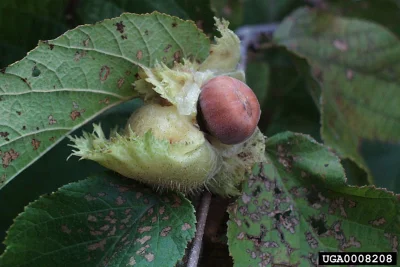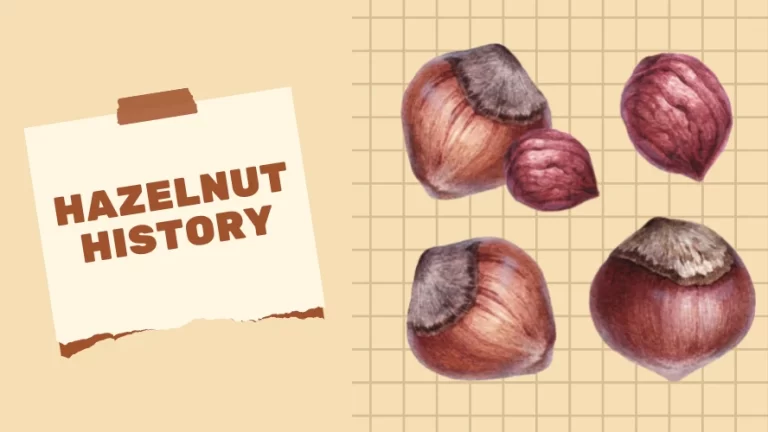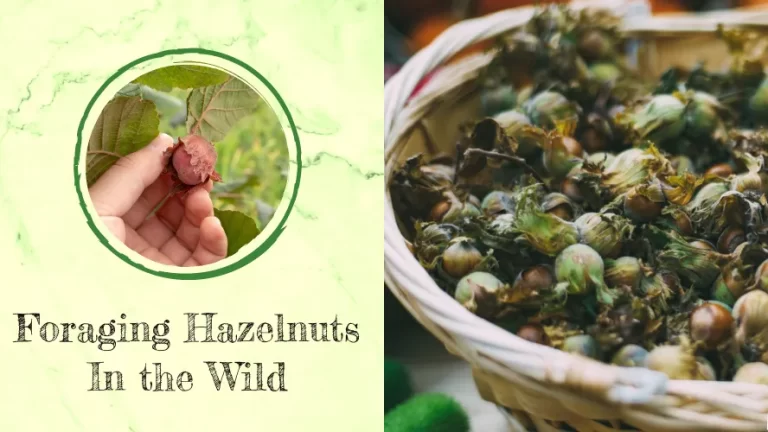Hazelnut Species Guide

Though seemingly similar at first glance, hazelnuts are a diverse group of nuts with distinct characteristics. With around 15 species in the Corylus genus, each one brings its unique attributes to the table.
Recognizing these differences is essential for farmers, who cultivate specific species to maximize yield, combat diseases, and cater to consumer preferences. Additionally, those with a keen interest in botany can appreciate the diversity of the hazelnut family.
This article will explore some of the most prominent hazelnut species. We will examine their distinguishing features, native habitats, and impact on the hazelnut industry.
Hazelnut Species and Varieties: Avoiding Confusion
Before diving into hazelnut species, it’s worthwhile to emphasize that species shouldn’t be confused with varieties (or “cultivars”). Although “species” and “varieties” are sometimes used interchangeably, they have distinct meanings in the context of plants. By understanding these terms and their implications, we can more effectively appreciate the magnificence of this nut family.
Definition of hazelnut species
When it comes to hazelnuts, the term “species” specifically refers to the different types of hazel trees (genus Corylus) that produce these edible nuts. Each hazelnut species is distinct, with its unique set of characteristics, such as growth habit, leaf shape, and nut size, among others. These differences result from the tree’s genetic makeup, which has evolved over time in response to factors like geography, climate, and ecological conditions.
Therefore, when we talk about species in the context of hazelnuts, we refer to the various types of hazelnuts produced from different trees within the Corylus genus.
Regarding the different varieties, you can learn more about them in our blog post about the most popular hazelnut cultivars.
The Most Popular Hazelnut Species
Hazelnuts belong to the genus Corylus, comprising 15 different hazel tree species. Each one displays distinct characteristics, such as growth habits, leaf shape, and nut size. We will introduce you to some of the most notable species. We will provide insights into their unique features and the regions where they are commonly found.
Corylus avellana (European hazelnut)
Corylus avellana, typically known as the European or Common hazelnut, is the most widely cultivated hazelnut species. Originally from Europe and western Asia, it thrives in temperate climates with well-drained soils. The European hazelnut typically grows as a large shrub or small tree, reaching heights of up to 12-20 feet (3.7-6 meters).
The nuts produced by Corylus avellana are encased within a leafy, fringed husk and exhibit a rounded, oval shape. Typically found in clusters of 1 to 5, these nuts boast a yellow-brown hue and measure approximately 0.6-1.2 inches (1.5-3 cm) in length. Ripening in late summer, they fall from the involucre, about 7 to 8 months post-pollination.
This species is well-known for producing nuts with a delicate, sweet flavor and, at the same time, a good size. That’s why it is considered one of the top choices.
Corylus avellana is also the parent species of many cultivated varieties, which have been selectively bred for traits like larger nut size, higher yield, and resistance to pests or diseases.
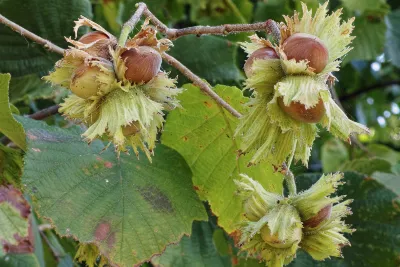
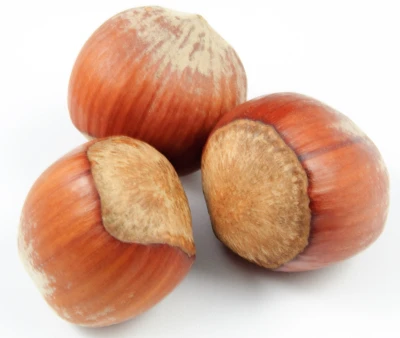
Corylus americana (American hazelnut)
Corylus americana, also known as the American hazelnut, is native to North America. It is found primarily in the eastern and central regions of the United States and parts of Canada. This species typically grows as a deciduous, multi-stemmed shrub, reaching heights of 8-16 feet (2.5-5 meters), and is well-adapted to a wide range of soil types and environmental conditions.
The American hazelnut produces smaller nuts than other species often favored for cultivation. The nuts are enclosed in a leafy, short-tubed husk, which changes color from green to brown as the nuts ripen. They have a sweet and mild flavor.
While it is not as widely cultivated as its European counterpart, its resilience to local pests, diseases, and cold temperatures makes it an attractive option for cultivation in North America. Additionally, its ability to attract wildlife, such as birds and small mammals, makes it a valuable species for promoting biodiversity in gardens and natural habitats.

Corylus cornuta (Beaked hazelnut)
Corylus cornuta, or the beaked hazelnut, is a North American native species comprising two distinct subspecies.
- Corylus cornuta var. cornuta, or Eastern beaked hazel, grows from Canada to Georgia. This small deciduous shrub reaches heights of 13-20 feet (4-6 meters) and thrives in various soil conditions, including rocky or sandy soils.
- Corylus cornuta var. californica, also known as Western beaked hazel or California hazel, is found along the west coast from Alaska to California. It’s larger than its eastern counterpart, growing between 13-49 feet (4 to 15 meters) tall.
The beaked hazelnut is characterized by its elongated, tubular husk that envelops the nut, resembling a bird’s beak. The nuts are smaller than those of European and American hazelnuts, measuring around 0.79-1.57 inches (2-4 cm). With a sweet and mildly nutty flavor, these nuts are enjoyed by humans and wildlife, including birds and mammals.
It’s not widely cultivated commercially but is valued for its ornamental appeal, soil stabilization properties, and significant role in supporting local ecosystems. Its increased resistance to diseases compared to the European hazel has led to its use in breeding programs, aiming to develop high-yielding and disease-resistant hybrids.
Native Americans used nuts from this species extensively. Finally, it’s worth mentioning that the beaked hazelnut is the hardiest species in the Corylus genus.
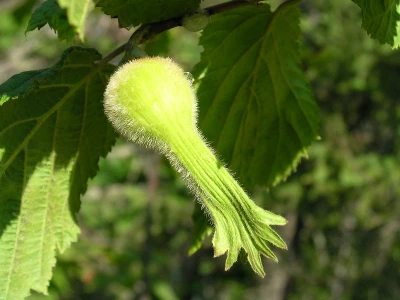
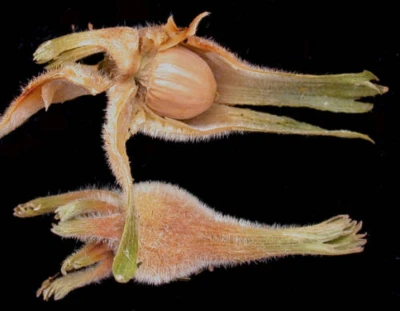
Corylus maxima (giant hazel or giant filbert)
Corylus maxima, also known as the giant hazel or giant filbert, originates from southeastern Europe and western Asia. It is characterized by its large nut size and elongated, pendulous catkins. The giant hazel typically grows as a large, deciduous shrub, reaching 12-15 feet (3.6-4.5 meters).
Corylus maxima nuts are enclosed in a fringed, tubular husk, similar to the beaked hazelnut, but larger and more pronounced. The nut is comparable to the European hazelnut, growing in clusters of 1 to 5 and measuring 0.6-1 inch (1.5-2.5 cm). These nuts boast a rich, sweet flavor and a slightly firm texture, making them a highly valued crop.
The giant hazel does not compete with the most popular species on the commercial stage but plays different meaningful roles. This species has contributed to the developing of several well-liked cultivars, known for their large, flavorful nuts and ornamental appeal.
The distinctive catkins and unique husks of the giant hazel make it an attractive addition to gardens and landscapes. In addition, its nuts are a valuable food source for wildlife.
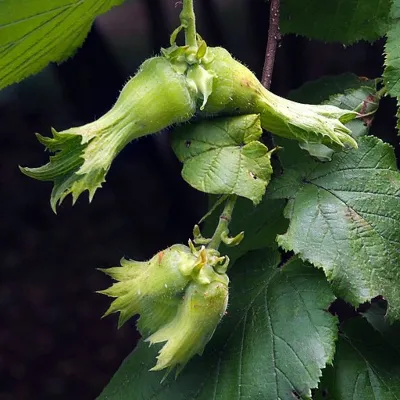
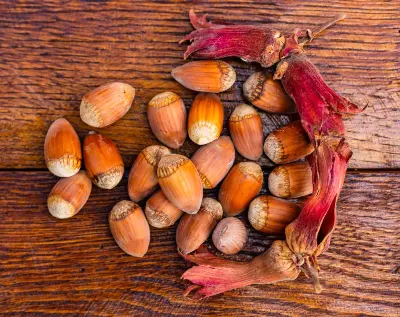
Corylus colurna (Turkish hazelnut)
Corylus colurna, commonly called Turkish hazelnut or Turkish filbert, hails from southeastern Europe and western Asia. It has significant populations in the Balkans, Turkey, and Iran. Distinct from other hazelnut species, it typically grows as a medium-sized, deciduous tree, reaching 82 feet (25 meters). The pyramidal shape and dense branching pattern make it an attractive option for urban landscaping and windbreak trees.
Corylus colurna nuts are on the smaller side, measuring approximately 0.4-0.8 inches (1-2 cm) in length. They grow in clusters of 3 to 8 nuts and are enclosed in a 0.12-inch (3 mm) thick husk.
Though their flavor resembles the European hazelnut, the Turkish hazelnut’s thick outer shell and smaller size render it less valuable.
One of the areas in which this species excels is in commercial hazelnut orchards, thanks to its non-suckering nature. It serves as an excellent rootstock for grafting nut-bearing common hazel cultivars.
The Turkish hazelnut also holds value for its ornamental and environmental advantages. Its ability to withstand harsh urban conditions, such as pollution and poor soils, makes it a prime candidate for city parks and streetscapes.
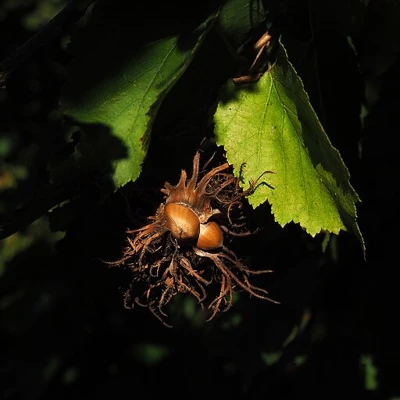
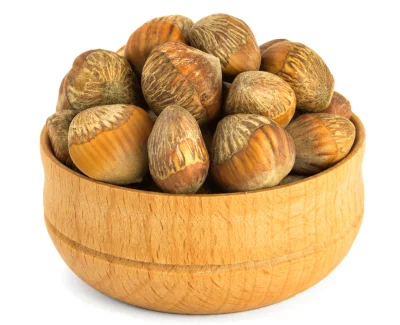
Corylus heterophylla (Asian or Siberian hazelnut)
Corylus heterophylla, often referred to as the Asian or Siberian hazelnut, originates from eastern Asia, including regions like China, Japan, Korea, and Siberia. It usually grows as a deciduous shrub or small tree, reaching up to 23 feet (7 meters) in height. Asian hazelnuts are known for their alternate, irregular leaves, which is why the species is named “heterophylla,” which translates to “different leaves.”
Corylus heterophylla nuts are small, ranging from 0.3 to 0.6 inches (0.7 to 1.5 cm) in size. They possess an ovoid-globose shape and are encased in a leafy, short-tubed husk. These nuts offer a high-quality taste, boasting a sweet and mild flavor like other species.
Corylus heterophylla is commercially cultivated in China. In other regions where it is native, the nuts are harvested from the wild and sold on local markets.
A fascinating aspect of Corylus heterophylla is its ability to withstand extremely low temperatures during dormancy. It can tolerate temperatures as low as -13°F (-25°C).
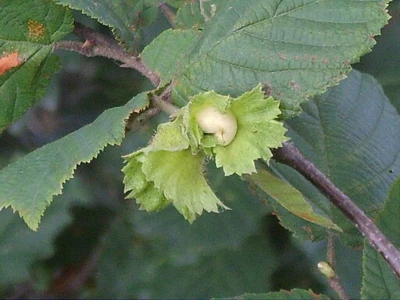
Other Hazelnut Species
In addition to the primary species discussed above, several others are worth noting.
These lesser-known species may not have the same commercial importance, but they still play a role in local markets. On top of that, they give us a better overall understanding of the rich diversity within the Corylus genus.
- Corylus chinensis: Chinese Hazelnut. Native to China.
- Corylus colchica: Colchican Hazelnut (the same as Corylus iberica). Found in Armenia and Georgia in the Caucasus region.
- Corylus fargesii: Farges or Chinese hazelnut. Native to China.
- Corylus jacquemontii: Jacquemont’s Hazelnut. Found in the Himalayan regions of India, Nepal, and Bhutan.
- Corylus sieboldiana: Asian beaked hazel (the same as Corylus mandshurica). Native to northeastern Asia and Japan.
- Corylus tibetica: Tibetan or Himalayan hazelnut (the same as Corylus ferox). It originates from the Himalayas of eastern Asia.
- Corylus wangii: Wang’s Hazelnut. Native to China.
- Corylus yunnanensis: Yunnan Hazelnut. Native to China.
Conclusion
The hazelnut family is a testament to the incredible variety and diversity found in nature. With each species originating from different regions and exhibiting unique characteristics, these nuts offer a fascinating glimpse into the world of plants and their adaptation to various environments.
Gaining a deeper understanding of the diverse hazelnut species and their unique characteristics, growth patterns, and flavors allows us to appreciate the richness and intricacy within the Corylus genus.
Furthermore, we can acknowledge the significant contributions these species make to agriculture, wildlife sustenance, and the culinary enjoyment that enriches our daily lives.
